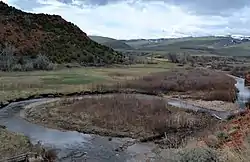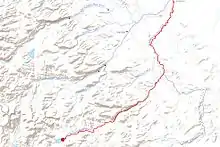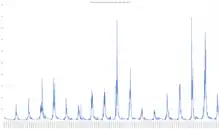| Little Popo Agie River | |
|---|---|
 The Little Popo Agie River near Red Canyon. | |
 The course of the Little Popo Agie River | |
| Etymology | word po-PO-shuh, meaning "Head River"[1] or possibly "Gurgling River" [2] |
| Location | |
| Country | United States |
| State | Wyoming |
| Physical characteristics | |
| Source | Christina Lake[3] |
| • location | Wind River Range, Fremont County |
| • elevation | 10,000 ft (3,000 m) |
| Mouth | North Fork Popo Agie River |
• location | Hudson, Wyoming |
• coordinates | 42°54′16″N 108°35′21″W / 42.9045°N 108.5893°W |
• elevation | 5,000 ft (1,500 m) |
| Length | 58 mi (93 km),[3] |
| Basin features | |
| Tributaries | |
| • left | Beason Creek,[3] Willow Creek[3] |
| • right | Twin Creek,[3] Red Canyon Creek[3] |
The Little Popo Agie River runs through unincorporated portions of Fremont County Wyoming. The river's headwaters are at Christina Lake in the Wind River Range, and it flows a total of 58 miles (93 km)[3] until its end near Hudson, Wyoming. The river is one of three sharing the name "Popo Agie", the others include the Middle Fork Popo Agie and the North Fork Popo Agie River.
Course
The river's head is about 10,000 feet (3,050 m) above sea level, and its end is at around 5,000 feet (1,520 m) above sea level.[3]

History
During the 19th Century, areas along the river were the site of violent encounters between the U.S. Army and Native Americans. On July 1, 1875, an army cavalry detachment documented killing two Native Americans near the river.[5]
Pollution
Since at least the early 20th Century, some sections of the river have had problems with pollution thought to have come from industrial operations at nearby oil extraction sites.[6] Around 1907, sufficient oil waste was reportedly being dumped into the Little Popo Agie River. This led to several lawsuits being filed for damages by locals using the river's water for irrigation against oil companies operating in the area.[7] Pollution from oil waste was linked to decreased fish habitat on the river in the 1950s.[6]
References
- ↑ Claude E. Jamison; Wyoming. State Geologist (1911). Bulletin. State Geologist. p. 7.
- ↑ "Sinks Canyon State Park History". Wyoming State Parks, Historic Sites & Trails. State of Wyoming. Retrieved Feb 28, 2017.
- 1 2 3 4 5 6 7 8 "Popo Agie Hydrology". Popo Agie Conservation District. Popo Agie Conservation District. Retrieved Feb 28, 2017.
- ↑ "USGS 06233000 LITTLE POPO AGIE RIVER NEAR LANDER, WY". nwis.waterdata.usgs.gov. usgs. October 15, 2019. Retrieved October 15, 2019.
- ↑ George Washington Webb (1938). Chronological list of engagements Indian Wars USA 1790-1898. St.Joseph Mo. Wing Print. and Pub. Co. pp. 74.
- 1 2 Missouri Basin Field Committee (1952). Wind River Basin, Wyoming: Interim Report. Department of the Interior. p. 85.
- ↑ Sidney Paige (1911). Mineral Resources of the Llano-Burnet Region, Texas, with an Account of the Pre-Cambrian Geology. U.S. Government Printing Office. p. 152.